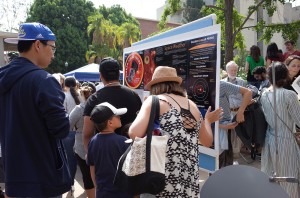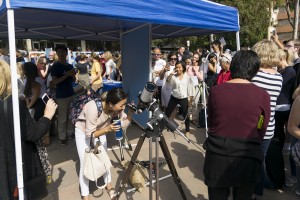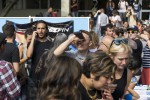A long line of people spiraled around the Court of Sciences to view the solar eclipse through telescopes last Monday.
More than a thousand students and community members came to campus to watch the partial solar eclipse at “The Great UCLA Eclipse” event hosted by the Earth, Planetary and Space Sciences department. Many waited in line to use solar telescopes for a closer look of the moon masking part of the sun.
Some viewers stood on the roof of Boelter Hall for a higher vantage point, while others stayed on the grass to soak in the view, relaxing on lawn chairs and blankets. Many participants raised their phones and cameras to try to photograph the sun. The event also featured posters and booths about the eclipse and solar-related research at UCLA from scientists in the astronomy and planetary science departments.

The moon began to cover the sun at 9:05 a.m. and continued to slide past until 11:44 a.m. About 35 percent of the sun’s disk was visible during the maximum point of the eclipse at 10:21 a.m.
“It (looked like) a little, orange crescent,” said Max Wang, a rising third-year electrical engineering student. “It’s cool that it’s a once-in-a-lifetime thing.”
The last total solar eclipse visible from the continental United States was in 1979. During the August 21 eclipse, observers all over North America could see the eclipse, and people in the path of totality from Salem, Oregon, to Charleston, South Carolina, were able to see the moon completely cover the sun.
Wang added he was excited to see the next total solar eclipse visible in the United States in 2024.

Organizers of the event ran out of solar glasses, which help protect eyes from the sun’s ultraviolet light, before the eclipse ended. However, some participants brought their own devices, such as glasses or pinhole cameras made from cereal boxes, and shared with others.
Hyunseok Kim, a graduate student in electrical engineering, and his labmates tried viewing the eclipse through filters they use for optics experiments.
“We just grabbed some of them to see if this works, and it kind of works,” Kim said. “Next time we gotta bring better equipment.”
Many participants used other methods to view the eclipse. Some put solar glasses on their phone cameras to reduce glare while photographing the sun.
Eugénie Suter, a medical resident at UCLA Mattel Children’s Hospital, shaped her hands to make a small hole toward the sun. The sunlight that passed through hit the ground in the shape of a crescent because of the partial eclipse.
“Instead of (sunlight) filling up the hole, there’s a crescent,” Suter said. “It’s kind of frustrating that you cannot get a round, normal (shape) because it feels like something is defective.”
Fekireselassie Beyene, a graduate student in earth, planetary and space sciences, worked a booth with a wooden cradle called a sunspotter. The device used a lens and mirrors to project an image of the eclipsed sun on a screen.
“You see the crescent moon all the time, but you never really see a crescent sun,” Beyene said. “I know it’s just an optical illusion, but at the same time it’s a pretty cool thing to see.”
